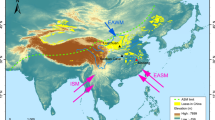Abstract
The concentrations of Rb and Sr, and magnetic susceptibility in loess and paleosol samples from the Luochum profile have been measured. The loess units deposited in different geological periods display a very similar pattern of Rb and Sr distribution while paleosol units exhibit a dramatic increase in the Rb/Sr ratio, ranging from 20% to 120% in increase amplitude. Owing to different geochemical behavior of the two elements, Rb appears to be immobile while Sr appears to be mobile in the processes of weathering and pedogenesis. So variations of the Rb/Sr ratio in the loess-paleosol sequences could reflect intensities of weathering and pedogenesis, thus recording the relative wind strength of the East Asian summer monsoon circulation. This could be supported by the high degree of cornlation between the Rb/Sr ratio and the magnetic susceptibility. A continuous record of the Rb/Sr ratio in the Luochuan profile over the last 800 ka bears a striking resemblance to the δ18 O curve of the deep sea sediments and is in accordance with the SPECMAP chronology. Such similarity between the terrestrial and the deep sea records suggests that variability in global ice volume is a primary dynamic factor controlling long-term changes of the East Asian summer monsoon intensity.
Similar content being viewed by others
References
Ding, Z. L., Sun, J. M., Zhu, R. X. et al., Eolian origin of the Red Clay deposits in the Loess Plateau and implications for Pliocene climatic changes,Qllaternary Sciences, 1997, (2): 147.
Sun, D. H., Liu, T. S., Chen, M. Y. et al., Magnetostrtigraphy and paleoclimatic interpretation of the Red Clay from the Chinese Loess Plateau,Sciences in China (in Chinese), Ser. D, 1997, 27(3): 265.
An, Z. L., Wu, X. H., Wang, P. X. et al., Paleomonsoons of China over the last 130,000 years,Science in China, Ser. B, 1991, 34(10): 1076.
An, Z. L., Wu, X. H., Wang, P. X. et al., Paleomonsoons of China over the last 130,000 years,Science in China, Ser. B, 1991, 34(11): 1209.
Gallet, S., Jahn, B. M., Toni, M., Geochemical characterization of the Luochuan loess-paleosol sequence, China, and paleoclimatic implications,Chem. Geol., 1996, 133: 67.
Dasch, E. J., Strontium isotopes in weathering profiles, deep sea sediments and sedimentq rocks,Geochim Cosmochim Acta, 1969, 33: 1521.
Liu, T. S.,Loess and the Environment (in Chinese), Beijing: Ocean Press, 1985.
McFarlane, A. W., Geology and major and trace element chemistry of late Archean weathering profiles in the Fortescue Group, western Australia: implications for atmospheric CO2,Precambrian Research, 1994, 65: 297.
Chen, J., Ji, J. F., Qiu, G. et al., Geochemical studies on the chemical intensities of the Luochuan loess-paleosol sequence,Science in China (in Chinese), Ser. D, 1997, 27(6): 531.
Goldich, S. S., Gast, P. W., Effects of weathering on the Rb-Sr and K-Ar ages of biotite from the Morton Gneiss, Minnesota,Earth Planet Sci. Lett., 1966, 1: 372.
Chen, J., Wang, H. T., Lu, H. Y., Behaviours of REE and other trace elements during pedological weathering Evidence from chemical leaching of loess and paleosol from the Luochuan Section in Central China,Acta Geologica Sinica, 1996, 9(3): 290.
Kukla, G., Heller, F., Liu, X. M. et al., Pleistocene climates in China dated by magnetic susceptibility,Geoloy, 1988, 16: 811.
Imbrie, J., Hays, J. D., Martinson, D. G. et al., The orbital theory of the pleistocene climate: Support from a revised chronology of the marine 618 0 record, inMilankuuitch and Climate, Part I ((eds. Berger, A., Imbrie, J., Hays, J. et a1.), Dordrecht: ReidelPubl. Co., 1984, 269–305.
Prell, W. L., Kutzbach, J. E., Monsoon variability over the past 150000 years, J.Geophys. Res., 1987, 92: 8411.
Hoffmann, G., Heimann, M., Water isotope modeling in the Asian monsoon region,Quaternary International, 1997, 37: 115.
Author information
Authors and Affiliations
Additional information
Project supported by the National Natural Science Foundation of China (Grant No. 49725307).
Rights and permissions
About this article
Cite this article
Chen, J., An, Z., Wang, Y. et al. Distribution of Rb and Sr in the Luochuan loess- paleosol sequence of China during the last 800 ka. Sci. China Ser. D-Earth Sci. 42, 225–232 (1999). https://doi.org/10.1007/BF02878959
Received:
Issue Date:
DOI: https://doi.org/10.1007/BF02878959




